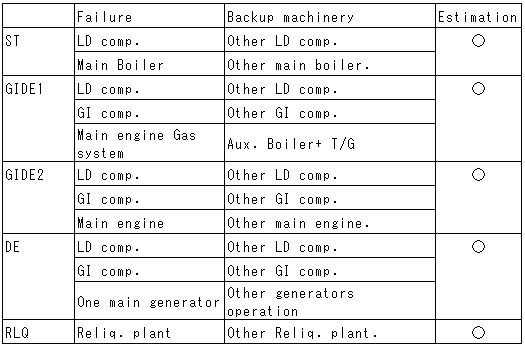3.4 Reliability of Propulsion
The key technologies of propulsion plants such as low speed diesel, medium speed diesel, steam turbine, electric propulsion technology are well proven in the marine field. Therefore, the reliability of propulsion plants is considered to be sufficient for the next generation of LNG carriers. And regarding an availability of plant there is difference between each system. ST is considered to be the most available of all propulsion plants.
3.5 Redundancy of BOG Utilization
The redundancy of BOG utilization is defined as being able to utilize or treat natural BOG without loss after any single failure in the system. The results of the evaluation are shown in Table 6. This table shows that all plants have good redundancy for BOG utilization at Sea.
During slow steaming or stopping, RLQ has a redundancy advantage in BOG treatment i.e. only this plant can treat gas without dump.
Table 6 Redundancy of BOG utilization

3.6 Operation and Maintenance
ST can be operated at any oil/gas ratio with dual fuel main boilers, while RLQ cannot operate using BOG as fuel i.e. it only uses fuel oil. Dual fuel diesel engines need a little fuel oil as pilot fuel for gas operation whichever low or medium speed.
As the maintenance cost has been estimated in Section 3.2, maintenance flexibility is discussed in this section. Because diesel engine has many friction parts, the plant using diesel engines during normal sea going require scheduled maintenance or inspection. Thc maintenance of GIDE1, GIDE2 and RLQ is done while the ship stops, because heavy parts handling may be needed. However light inspection may be done during ballast voyage. DE is able to sail even if one diesel generator is in maintenance.
3.7 Exhaust Gas Emission
The environmental emission control of the vessel is an important factor in selecting the propulsion system for the next generation of vessels. NOx and CO2 emission levels are shown in Table 7. Regarding exhaust gas emissions, the NOx level of the conventional steam turbine plant is considerably smaller than that of the diesel engine plant. However, NOx emission from diesel engine can be reduced with additional countermeasures such as SCR, water emulsion fuel etc. The CO2 level decreases in proportion to the thermal efficiency of plant or the carbon content of fuel.
SOx emission level is related to the sulfur content of fuel, therefore, the plants using BOO as fuel have a lower reduce SOx emission level.
Table 6 Exhaust Gas Emission Levels

4. CONCLUSION
Features of the alternative propulsion systems are evaluated from several important viewpoints and compared. The summary is shown in Table 7. Taking all features into consideration, GIDE2 is the most suitable for the alternative propulsion plant of the next generation for LNG carriers.
DE also has the potential for redundancy of both propulsion and BOG utilization, however the result of total evaluation is lower due to its high capital cost. Although the pod propeller is considered for DE in this paper, the diesel electric propulsion concept with the conventional type propulsion motors may be competitive to the GIDE2.
On the other hand, Table 7 shows ST has an advantage in the flexibility of fuel and maintenance.
BACK CONTENTS NEXT